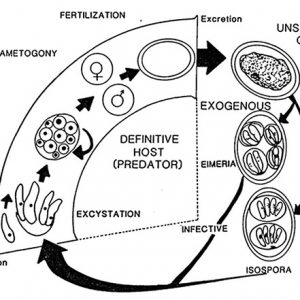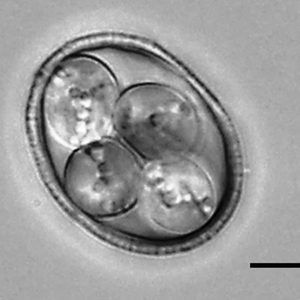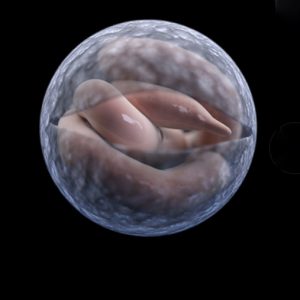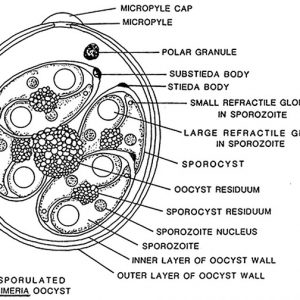calsfoundation@cals.org
Coccidia
Coccidians are microorganisms belonging to the Phylum Apicomplexa and Suborder Eimeriorina, which includes eight to thirteen families, about 39 genera, and well over 2,000 species. These protists are intracellular (meaning they function inside the cell) parasites of medical and veterinary importance, including those in the genera Caryospora, Cryptosporidium, Cyclospora, Eimeria, Isospora, Sarcocystis, and Toxoplasma. Most are considered intestinal parasites that infect both invertebrates as well those animals in all vertebrate classes. These parasites cannot complete their life cycle without exploiting a host. Coccidiosis is a general term for the disease they can cause, and it is recognized as a major health concern in wild animal populations, domestic animals, and zoo animals. However, some infections appear not to cause any pathology in hosts with healthy immune systems. Coccidiologists are just now starting to realize the diversity of species of coccidians in Arkansas, and also abroad, with ongoing studies designed to increase knowledge of the systematics, natural history, and ecology of these parasites.
American researchers who investigate the systematics and taxonomy of coccidians have a revolving challenge because the older literature is vast and widely scattered, much of it appearing in obscure journals with limited circulation, offering descriptions of poor quality or with no photomicrographs (digital photos taken through a microscope) at all, and in languages other than English. Therefore, many species descriptions remain unclear, and redescriptions are warranted. Major works on the coccidia include those of László P. Pellérdy and Norman D. Levine, whose publications are useful but contain incomplete data on hosts and their localities and, thus, are of limited value. These problems make organizing the taxonomic literature on a particular group difficult, and differentiating species can be “best-guess” work even for an experienced taxonomist. However, more recent publications, including an online database of Coccidia of the World by renowned coccidiologists Donald W. Duszynski and Steve J. Upton, have updated scientific knowledge and summarized non-human coccidians in vertebrate groups such as amphibians, turtles, snakes, insectivores (moles and shrews), bats, primates, and lagomorphs (rabbits and hares).
Nevertheless, much remains to be gained by studying those coccidians about which little is known (less than five percent of all potential vertebrate host species have been examined), including those infecting invertebrates, fishes, lizards, crocodilians, birds, and other mammals (especially rodents, the largest order of mammals) that hopefully would lead to monographs on such taxa. Indeed, more recently, examination of endogenous stages, which occur internally in tissues (usually intestinal) and advances in molecular technologies (DNA sequencing) and electron microscopy provide the opportunity to realize the complexity of coccidians. However, limitations on coccidial research include the small number of hosts sampled in biodiversity surveys, protected (endangered or threatened) host species, small volume of feces and oocysts recovered in surveys, and difficulties in amplifying and sequencing DNA from limited numbers of oocysts. In addition, study of some host species is now hampered by severe restrictions by state and federal agencies because of fear of spreading diseases such as white-nose syndrome in bats or chytrid fungus in amphibians.
Compared to other parasites, coccidians have a rather complex life cycle, with three sequential stages, including reproduction by endogenous (intracellular) merogony and gamogony followed by sporogony, which is extracellular (the oocyst). The oocyst is a cyst containing the fertilized cell, called the zygote. This complexity results in some stages of the same species being described in the older literature as different species, or even placed in different higher taxa (genera to suborders), before their basic life history was known.
Interestingly, the oocyst is highly resistant to all known fixative techniques (formalin, ethanol, polyvinyl alcohol, etc.), and the majority of all species descriptions are based on the oocyst. No satisfactory method is known to preserve its structural features permanently, so the taxonomy of coccidians has generally been non-specimen-based. As a result, many species are described solely on measurements of different structures of the infective sporulated oocyst, some additional key qualitative features (particularly shape), line drawings, and consideration of host species and geographic range. Although line drawings and photomicrographs (photosyntypes) are accepted as type specimens for organisms that cannot be preserved, the International Code of Zoological Nomenclature has not yet addressed this issue adequately.
One genus of coccidia, Cryptosporidium, has emerged as a serious human pathogen. It was unrecognized until 1976 as a cause of illness in humans. Various species infect other animals (primarily mammals) causing a waterborne diarrheal disease termed cryptosporidiosis. Its small size (less than 10 micrometers), low infectious dose, resistance to chlorination, and hardiness in the environment has made it a uniquely problematic organism for health professionals. This parasite is unique in that it is protected by a resistant outer shell that allows it to survive outside the body for long periods of time, making it very tolerant to chlorine disinfection. While this coccidian can be spread in several different ways, drinking contaminated water is the most frequent method of transmission. Ingestion of oocysts leads to cryptosporidiosis, which may range from asymptomatic to relatively mild cases of diarrhea to potentially life-threatening profuse watery diarrhea in patients who have weakened immune systems, such as those with AIDS.
To date, there are no drugs (coccidostats) that completely get rid of the disease—rather, they slow down the progression. Fortunately, in hosts with healthy immune systems, the disease is self-limiting in a few days. For humans, the anti-protozoal agent Nitazoxanide (Alinia) has been approved by the Food and Drug Administration (FDA) for treatment of diarrhea caused by Cryptosporidium in people with healthy immune systems; however, the effectiveness of Nitazoxanide in immunosuppressed individuals is unclear. In veterinary settings, particularly with dogs, the infection may be treated using sulfadimethoxine drugs such as Albon, Bactrovet, or Tribrissen.
Another pathogenic coccidian of humans (also perhaps in baboons, chimpanzees, and some other primates as well) is Cyclospora cayetanensis, which leads to a gastrointestinal disease, called cyclosporiasis, that may range from asymptomatic to debilitating. It was not fully recognized until the early 1990s and is most common in tropical to subtropical regions. It has been responsible for more than ten foodborne outbreaks affecting more than 3,000 people in the United States and Canada from the 1990s through 2014. During the summer of 2013, the Centers for Disease Control and Prevention (CDC) reported an unusually large number of cases of cyclosporiasis, and by October of the same year, the CDC had been notified of 641 cases from twenty-five states, primarily Iowa (140), Nebraska (87), and Texas (270). Epidemiological studies in Iowa and Nebraska showed that restaurant-associated cases were linked to a salad mix that contained contaminated iceberg and romaine lettuce, red cabbage, and carrots. In the Texas cases, investigation revealed that cilantro received from Puebla, Mexico, was the source.
The third pathogenic coccidian that affects humans worldwide is Toxoplasma gondii, which causes the disease toxoplasmosis. It was first described in 1908 at the Pasteur Institute in Tunis, Tunisia, and is capable of infecting nearly all endothermic (warm-blooded wild and domestic) animals. Nearly a third of the human global population has been exposed to—and may be chronically infected with—T. gondii. In healthy adult humans, no symptoms at all may be present, or a mild, flu-like illness can occur during the first few weeks following exposure. In infants, AIDS patients, and others who are immunocompromised, infection can lead to serious health problems (including ocular toxoplasmosis) and, sometimes, death. Interestingly, cats are considered the final hosts of T. gondii, with all other endothermic animals, including humans, serving as intermediate hosts. Infection in humans and other warm-blooded animals can occur: 1) by consuming raw or undercooked meat (particularly pork) containing T. gondii tissue pseudocysts with bradyzoites or by sporozoites in oocysts, 2) by ingesting water, soil, vegetables, or anything contaminated with oocysts shed in the fecal material of an infected animal, such as a domestic cat (this is the reason why pregnant women should not clean a cat’s litter box), 3) from organ transplantation or via tainted blood via a transfusion, and 4) by transplacental transmission from mother to fetus when the mother contracts the disease during pregnancy. More has been learned about T. gondii in the last few decades from the prolific publications of Jitender P. Dubey.
Because many coccidians have a resistant oocyst or sporocyst wall that is capable of surviving passage through the inhospitable gastrointestinal tract, some coccidians are found in feces of non-host species, particularly predators. Indeed, parasites from rodents or rabbits are frequently seen in the feces and intestinal contents of snakes, raptors, felids, or canids, while parasites from passeriform birds (birds that perch) are commonly found in herbivores, scavengers, and waterfowl that happen to ingest oocysts that have been deposited in feces on the ground or in water. In addition, coccidians of fishes are occasionally seen in fish-eating birds and snakes, invertebrate coccidians are very common in insect-eating hosts, and Pfeifferinella spp. of terrestrial or freshwater gastropods are occasionally found in turtles and waterfowl. As a result, these coccidians should be considered pseudoparasites just passing through the intestinal tract of an accidental host.
In Arkansas, there were no previous reports of coccidians infecting animals prior to 1975, when Leon W. Bone, then of the University of Arkansas (UA) in Fayetteville (Washington County), reported a coccidian (Eimeria pseudemydis) from a turtle, the red-eared slider (Trachemys scripta elegans), collected from Lonoke (Lonoke County). Since that time, however, there has been an explosion in the description of new and previously described species of coccidians from animals in the state such as amphibians (salamanders, frogs, and toads), reptiles (lizards and snakes), and mammals (particularly bats). Just concerning potential mammalian hosts alone, approximately 600 species (eleven percent) of all mammals have been examined for coccidia worldwide (to include only a few bats, insectivores, and rodents in Arkansas), and about 1,000 coccidian species have been identified, of which there are approximately 800 Eimeria spp. and 130 Isospora spp. Extrapolating from these estimates, there are about two species of coccidian per mammal host species. Therefore, if all named mammalian hosts were examined, there may be another 10,000 or more eimeriid species yet to be discovered infecting just mammals alone, which number more than 52,000 species.
For additional information:
Dubey, Jitender P. “The History and Life Cycle of Toxoplasma gondii.” In Toxoplasma gondii: The Model Apicomplexan-Perspectives and Methods. 2nd ed., edited by L. M. Weiss and Kami Kim. New York: Elsevier, 2013.
Duszynski, Donald W. The Biology and Identification of the Coccidia (Apicomplexa) of Turtles of the World. Amsterdam: Elsevier, 2014.
———. “Coccidia (Apicomplexa: Eimeriidae) of the Mammalian Order Chiroptera.” Special Publication of the Museum of Southwestern Biology 5 (2002): 1–45.
Duszynski, Donald W., and Steve J. Upton. The Biology of the Coccidia (Apicomplexa) of Snakes of the World: A Scholarly Handbook for Identification and Treatment. N.p.: CreateSpace, 2009.
———. “Coccidia (Apicomplexa: Eimeriidae) of the Mammalian Order Insectivora.” Special Publication of the Museum of Southwestern Biology 4 (2000): 1–67.
Duszynski, Donald W., Lee Couch, and Steve J. Upton. The Coccidia of the World Database. http://www.k-state.edu/parasitology/worldcoccidia/ (accessed September 22, 2021).
Levine, Norman D. The Protozoan Phylum Apicomplexa. Boca Raton: CRC Press, 1988.
Lindsay, David S., and Jitender P. Dubey. “Toxoplasmosis in Wild and Domestic Animals.” In Toxoplasma gondii: The Model Apicomplexan-Perspectives and Methods. 2nd ed., edited by L. M. Weiss and Kami Kim. New York: Elsevier, 2014.
McAllister, Chris T., Robert S. Seville, and Matthew B. Connior. “A New Caryosporan and Eimerian (Apicomplexa: Eimeriidae) from Green Anoles, Anolis carolinensis (Sauria: Dactyloidae), from Arkansas and Louisiana, with a Summary of the Coccidia of Dactyloidae.” Journal of Parasitology 100 (2014): 480–484.
McAllister, Chris T., Robert S. Seville, Robert Arlen, and Matthew B. Connior. “A New Species of Eimeria (Apicomplexa: Eimeriidae) from Tri-Colored Bats, Perimyotis subflavus (Chiroptera: Vespertilionidae), from the Ouachitas of Arkansas.” Acta Parasitologica 59 (2014): 690–693.
McAllister, Chris T., Robert S. Seville, Charles R. Bursey, Stanley E. Trauth, Matthew B. Connior, and Henry W. Robison. “A New Species of Eimeria (Apicomplexa: Eimeriidae) from the Green Frog, Lithobates clamitans (Anura: Ranidae) from Arkansas, U.S.A.” Comparative Parasitology 81 (2014): 175–178.
McAllister, Chris T., Robert S. Seville, Matthew B. Connior, Stanley E. Trauth and Henry W. Robison. “Two New Species of Coccidia (Apicomplexa: Eimeriidae) from Ground Skinks, Scincella lateralis (Sauria: Scincidae), from Arkansas, USA.” Systematic Parasitology 87 (2014): 85–90.
Ortega, Ynes R., Charles R. Sterling, Robert H. Gilman, Vitaliano A. Cama, and Fernando Diaz. “Cyclospora Species—A New Protozoan Pathogen of Humans.” New England Journal of Medicine 328 (1993): 1308–1312.
Ortega, Ynes R., and Roxana Sanchez. “Update on Cyclospora cayetanensis, a Food-Borne and Waterborne Parasite.” Clinical Microbiology Reviews 23 (2010): 218–234.
Pellérdy, László P. Coccidia and Coccidiosis. 2nd ed. Berlin: Verlag Paul Parey, 1974.
Thompson, R. C. Andrew, Anthony Armson, and Una M. Ryan, eds. Cryptosporidium: From Molecules to Disease. Amsterdam: Elsevier, 2004.
Chris T. McAllister
Eastern Oklahoma State College


 Coccidia Life Cycle
Coccidia Life Cycle  Coccidia from Bats
Coccidia from Bats  Cryptosporidium
Cryptosporidium  Sporulated Eimeria sp. Oocyst
Sporulated Eimeria sp. Oocyst 



Comments
No comments on this entry yet.